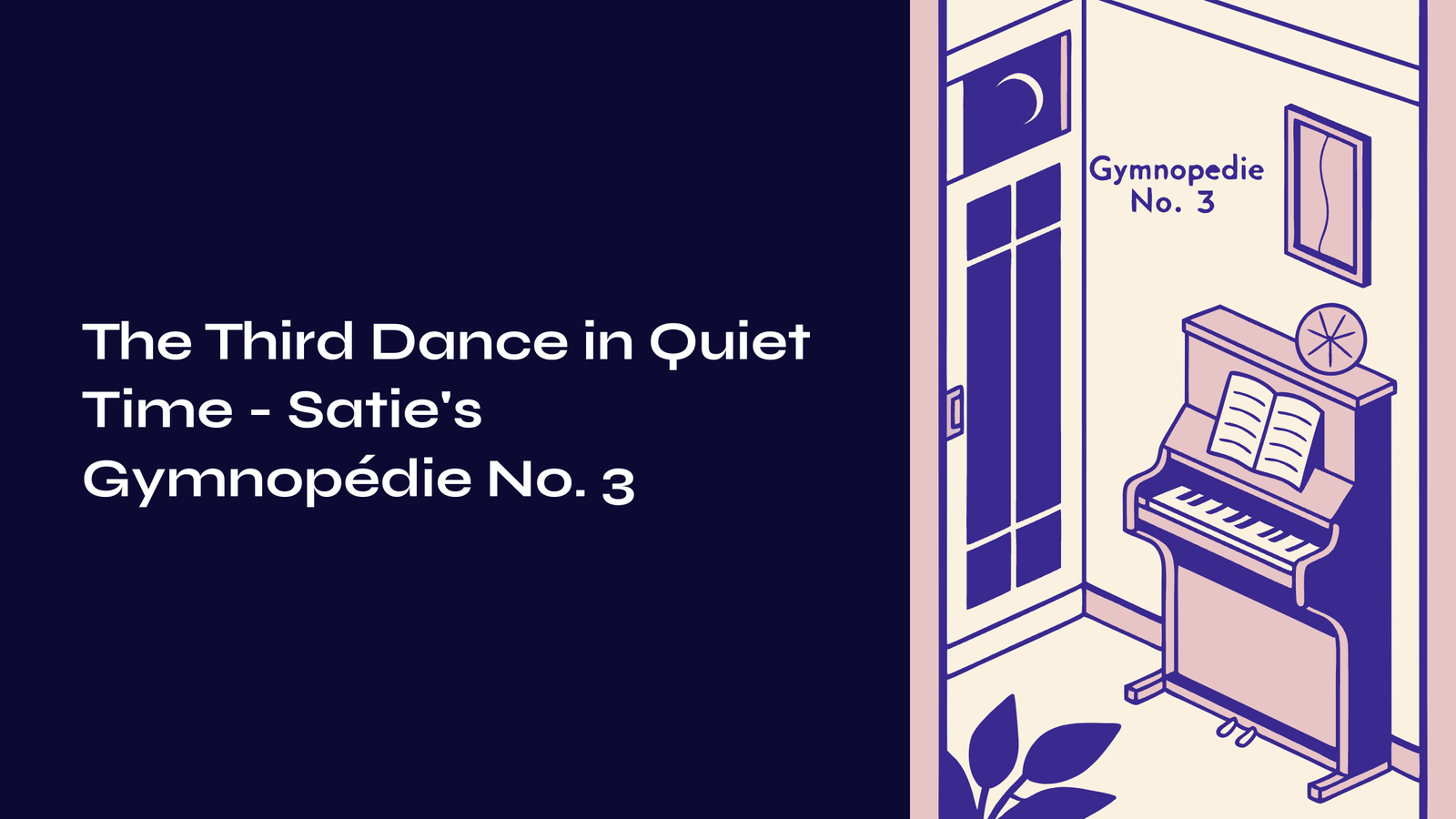Table of Contents
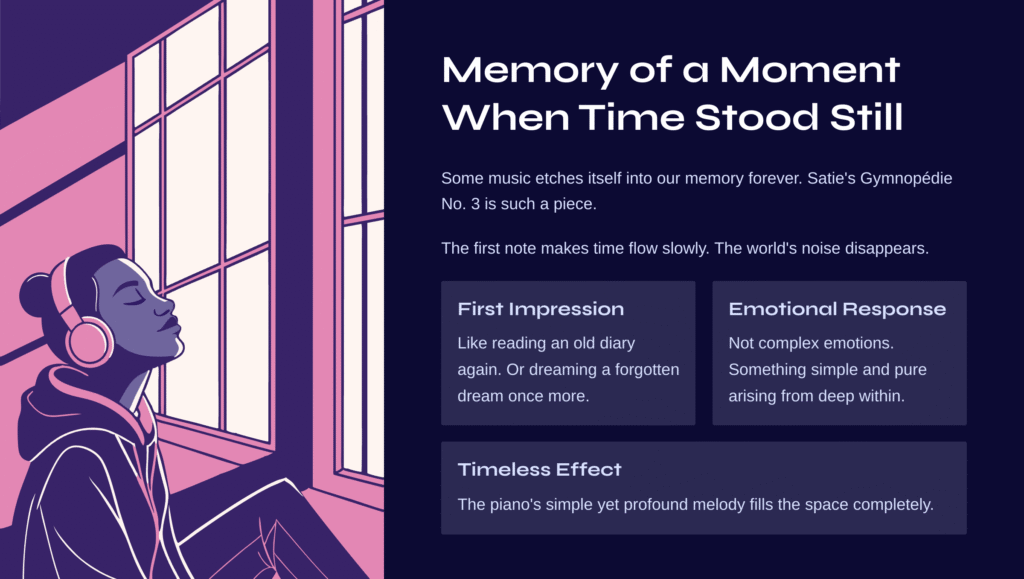
Memory of a Moment When Time Stood Still
Some music etches the moment we hear it into our memory forever. Satie’s Gymnopédie No. 3 was such a piece. The instant the first note rang out, it felt as though time began to flow slowly. All the noise of the world disappeared, and only the piano’s simple yet profound melody filled the space.
How should I describe the feeling of hearing this piece for the first time? It was like reading an old diary again, or dreaming a forgotten dream once more. Not complex emotions, but something very simple and pure slowly arising from deep within the heart.
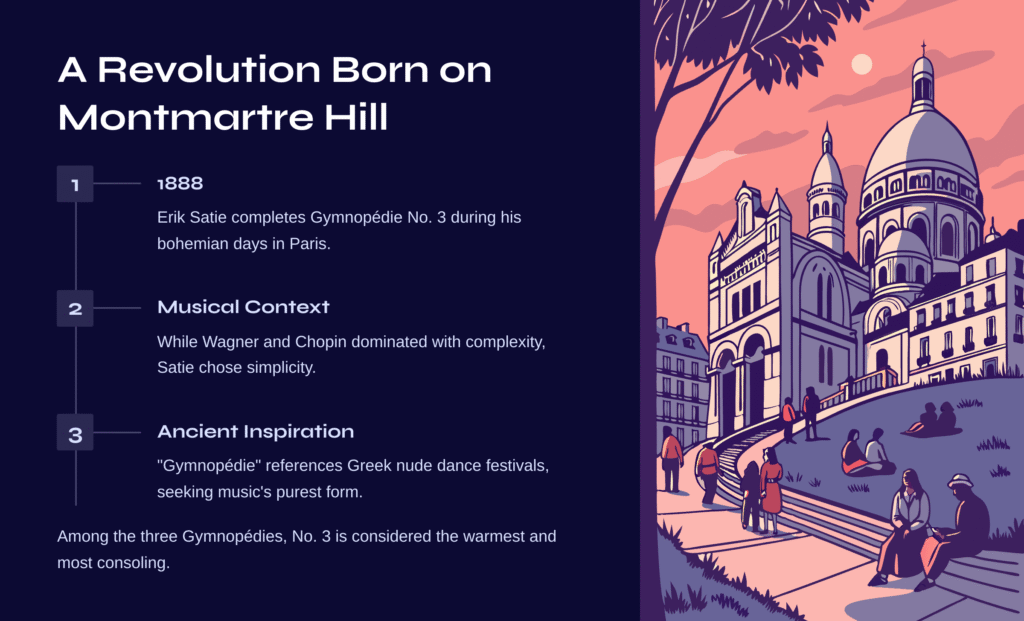
A Revolution Born on Montmartre Hill
Erik Satie completed Gymnopédie No. 3 in 1888, during his bohemian days on Montmartre Hill in Paris. The musical world of that time was dominated by Wagner’s grand narratives and Chopin’s elaborate emotional expressions, but Satie chose the opposite path. He sought to remove all unnecessary ornaments from music, leaving only what was most essential.
The title “Gymnopédie” itself is intriguing. Derived from the ancient Greek nude dance festivals, Satie seemed to want to return music to its most primitive and pure form through this reference. Among the three Gymnopédies, No. 3 is considered the warmest and most consoling.
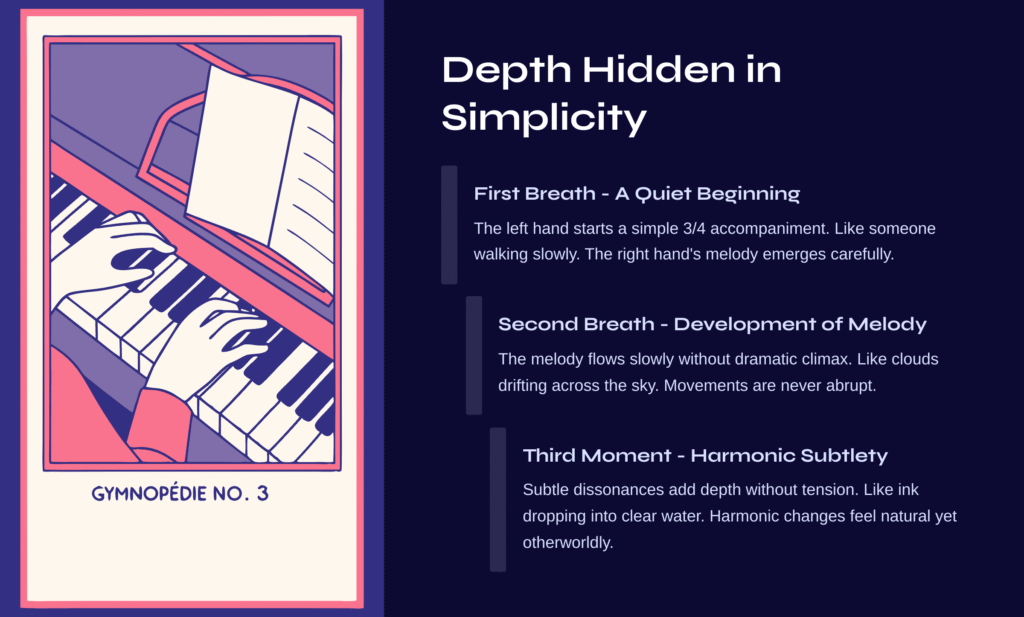
Depth Hidden in Simplicity
First Breath – A Quiet Beginning
When the piece begins, the left hand starts a simple accompaniment in 3/4 time. Like the footsteps of someone walking slowly, or the rhythm of quietly swaying trees—regular yet natural. Above this accompaniment, the right hand’s melody emerges, its first note like someone carefully starting a conversation.
Though in A minor, Satie rejects traditional harmonic tension and resolution. Instead, he uses modal harmonies that evoke the feeling of listening to medieval chant. This is the magic of Satie’s music. Neither sad nor joyful, emotions that are sufficient simply by existing.
Second Breath – Development of Melody
As the melody unfolds, we experience Satie’s unique sense of time. It doesn’t progress toward a dramatic climax like typical classical music. Instead, it flows slowly at the same level, like clouds drifting across the sky.
The right hand’s melody sometimes ascends and sometimes descends, but its movement is never abrupt. Like ripples created by a pebble dropped into a calm lake—quiet but definite movement. Because of these melodic characteristics, many people fall into a meditative state while listening to this piece.
Third Moment – Harmonic Subtlety
In this piece, Satie rejects traditional harmonic progressions and instead uses subtle dissonances. However, these dissonances don’t create tension. Rather, they add depth and color to the music. Like a drop of ink falling into clear water and slowly spreading.
The harmonic changes that appear especially in the middle section are truly beautiful. A sensation of suddenly being led to another world, yet even this change is natural and gentle. This might be the essence of what Satie called “furniture music.” Music that naturally permeates our daily lives while quietly comforting our emotions.

The Third Dance in My Heart
Every time I listen to this piece, I recall a certain afternoon from my childhood. Those times when sunlight streamed through windows and the house was quiet. Moments that were perfectly peaceful even when nothing special happened. Gymnopédie No. 3 evokes exactly such emotions.
While listening to the music, I sometimes want to dance. But not a vigorous dance—rather, I want to move slowly like leaves swaying in the breeze, or like cloud shadows floating over a calm sea. This might be the very feeling that the ancient Greek gymnopédie dances possessed.
Before Satie’s music, we need not prove or achieve anything. We realize that simply existing is enough. It’s amazing that such music was created in 1888. More than a century has passed, but the comfort and peace this music provides hasn’t changed a bit.
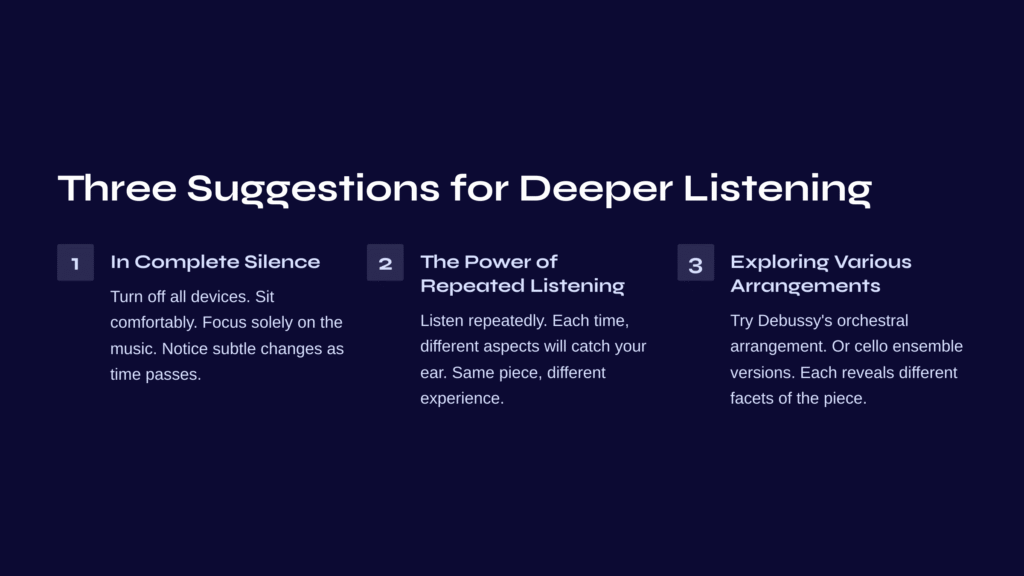
Three Suggestions for Deeper Listening
First – In Complete Silence
While this piece can be enjoyed as background music, if you seek true emotional impact, I recommend listening in complete silence. Turn off all electronic devices, sit comfortably, and focus solely on the music. It might seem monotonous at first, but as time passes, you’ll begin to notice the music’s subtle changes.
Second – The Power of Repeated Listening
Gymnopédie No. 3 is not a piece to hear once and forget. Listen to it repeatedly. Each time, different aspects will catch your ear. First listen for the overall atmosphere, second for the left hand’s accompaniment, third to follow the right hand’s melody. Though it’s the same piece, you’ll have a different experience each time.
Third – Exploring Various Arrangements
While the original is a piano solo, Debussy’s orchestral arrangement is also worth hearing. There are also cello ensemble versions, violin solo versions, and various other arrangements. Each version reveals different facets of the piece. The simplicity of piano, the richness of orchestra, the lyricism of strings—each version has its own charm.
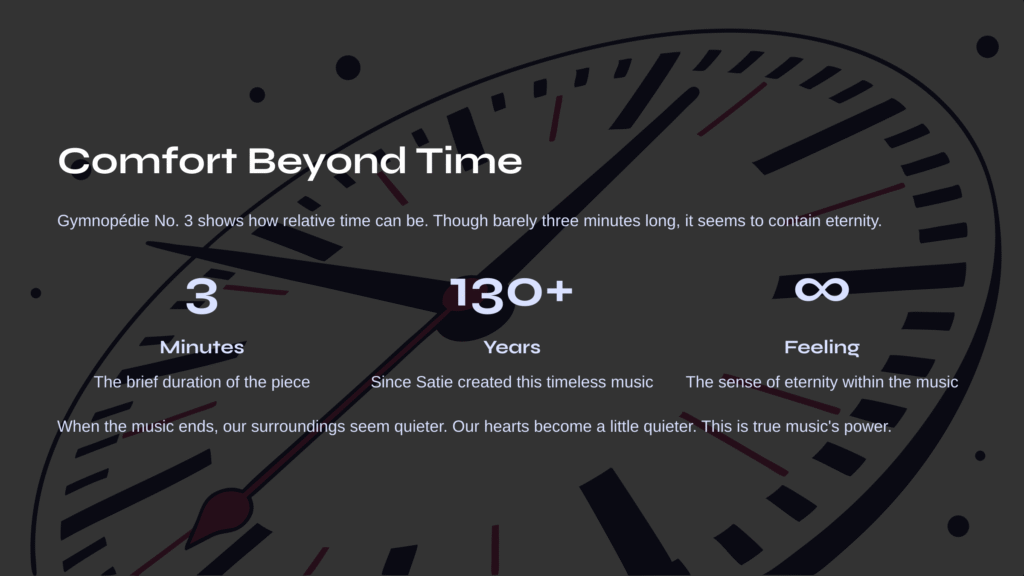
Comfort Beyond Time
Listening to Satie’s Gymnopédie No. 3, we realize how relative time can be. Though barely three minutes long, it seems to contain eternity. In our busy daily lives, let’s pause for a moment to listen to this music. We’ll discover that we too have such quiet and peaceful spaces within ourselves.
When the music ends, our surroundings seem a little quieter. No, more precisely, our hearts have become a little quieter. This is the power of true music. Not grand emotion or dramatic catharsis, but touching the most pure part within us. Satie had already created such music more than 130 years ago.
If today has been hectic, listen to this piece before sleeping. All the noise of the world will disappear, and you’ll meet the third Gymnopédie dancing slowly in the depths of your heart.
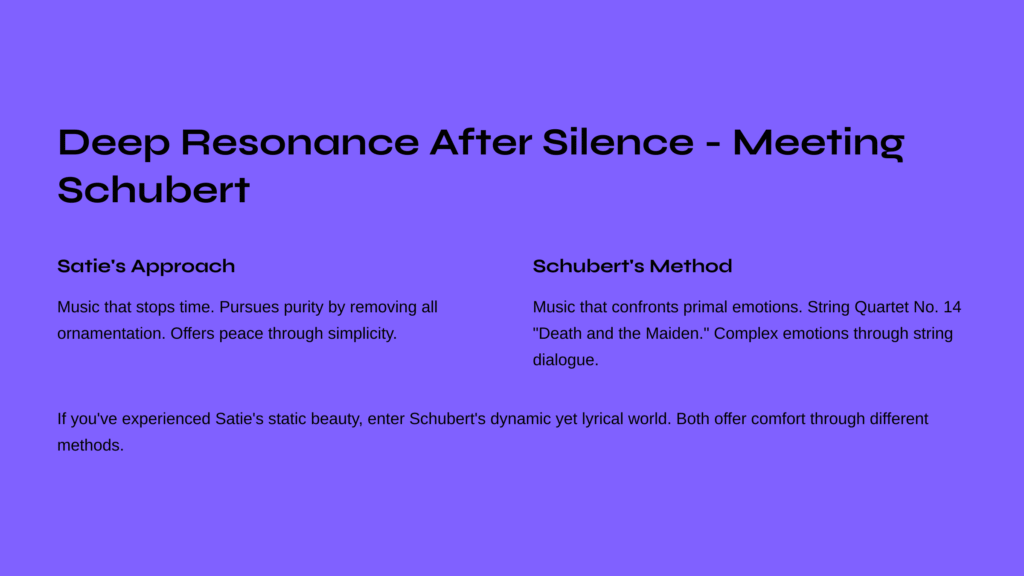
Deep Resonance After Silence – Meeting Schubert
After Satie’s quiet dance ends, a corner of our heart begins to long for slightly deeper emotions. At such times, I recommend Schubert’s String Quartet No. 14 “Death and the Maiden,” second movement.
If Gymnopédie No. 3 is music that stops time, Schubert’s second movement is music that makes us confront humanity’s most primal emotions within time’s flow. Where Satie pursued purity by removing all ornamentation, Schubert delicately portrays the complex and deep emotions of the human interior through the dialogue of string instruments.
The second movement’s theme is particularly taken from Schubert’s own song “Death and the Maiden,” the melody of death’s comfort offered to a young woman. But when arranged for string quartet, this melody develops beyond simple comfort into profound reflection on life and death. The way four string instruments sometimes unite in song and sometimes engage in individual dialogue resembles our heart’s various emotions conversing with each other.
If you’ve fully experienced Satie’s static beauty, now enter Schubert’s dynamic yet lyrical world. Both composers offer us comfort, but their methods are entirely different. Where Satie simplifies everything to provide peace, Schubert embraces all complex emotions to deliver true catharsis.
